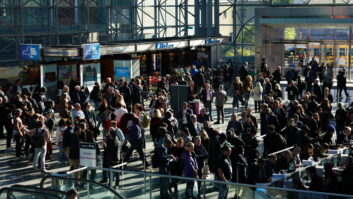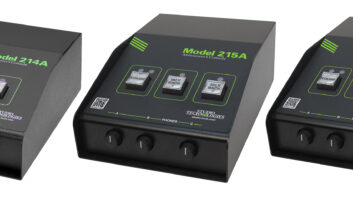A new level of control
Mar 1, 2006 12:00 PM, by Gordon S. Carter, CPBE CBNT

We live in an era of rapidly progressing technology. I was reminded of this when I began preparing this article. Three years ago I wrote a similar article, so I decided to look back and see how much has changed. I was surprised how much progress has been made in such a short period of time.
While analog audio consoles are still alive and well, many major audio console manufacturers no longer feature analog consoles at the top of their product lines. The analog boards that are available still range from the simple to the complex, but they are no longer the stars of the show. Stations with one control room or modest means can still use the analog consoles, but the possibilities offered by digital make it attractive to stations that want to build an integrated audio system.
Going digital
Digital consoles now cover the full range from economical to complete audio control systems. Several manufacturers now offer digital consoles in a small package. Some of these consoles are digital realizations of simple analog consoles, but others are feature-laden consoles in stand-alone packages, designed for the small station that wants an all-digital air chain. In many cases the digital consoles are comparably priced to similar analog consoles. Some of the stand-alone consoles can be added to larger systems in the future with little modification.

Stand-alone consoles, whether they are analog or digital, still have a practical place in many operations.
Many digital consoles have a great deal more flexibility than their analog cousins. Depending on the design of the console, you may have a lot more inputs and outputs than you may think necessary. The beauty of the digital console is that virtually any output can be used for any function. Depending on the console, you may be able to have multiple outputs follow a given front panel control, thus creating mix-minus or other special functions. Some even provide a group of user-assignable buttons with macro programmability, so you can perform a series of functions with the press of one button.
As the digital consoles become larger and more complex, they typically become part of a total system that includes a digital router and multiple consoles or control surfaces. Again, manufacturers have chosen slightly different paths to achieve the same ends. Some have chosen to create a router and include all the console functions in the router under software control. They then have one or more control surfaces that connect to the router to create a complete audio system. Others have chosen to include the typical functions of the console in the console, and then connect the console (one or more) to a router with fully integrated control in the console. To the end user, the results are the same: a fully integrated audio system. However, installation and maintenance are a bit different.
Some digital consoles, like analog consoles, only provide the basics of console operation: audio level control, on-off switching, bus assignment. Others provide additional functions commonly found only in high-end analog consoles, like equalization, dynamics processing (compression/limiting), and the ability to have multiple setups of the console. Almost all have some measure of automation interface. The ability to easily interface the consoles with automation systems makes them attractive to stations that are modernizing from older analog consoles.
The routers used with these systems are not your father’s routers. Previous generations of routers (mostly analog) simply routed the audio from one input to one or more outputs. Most were contained in a single chassis or modular chassis system, but needed to be in close proximity to unify the operation. The current digital routers may or may not include A/D converters on the inputs, but all provide some means of reclocking or synchronizing the digital signals coming in to them. This is necessary to prevent glitches when switching or mixing the signals. They are distributed systems, with a central unit (usually placed in a rack room or other location where audio signals enter and leave the facility. Smaller units can be placed in control rooms as needed to deal with local sources within that room, such as a CD player). The various units are connected by optical fiber or other means of data networking. The control surfaces connect to the nearest router chassis, but can control any source or destination in the system (depending on software rules set up by the system administrator). This type of system minimizes the amount of room-to-room wiring and greatly simplifies the total system. Again, depending on the design of the system, the router may contain all the control functions for the audio (level, routing and more) or some of these functions may be located within the console itself.

Most networked audio consoles are control surfaces that send commands to an audio engine.
In addition to the basic function of routing audio, the current digital routers can also route control signals. A couple of the control signals that can be routed are muting and machine control, such as start and stop. The flexibility of the router/control surface combination adds even more utility. You can set up multiple mix-minuses, route IFB signals for remotes and studios, and even provide full intercom functionality. The uses are limited only by your imagination.
With all this flexibility there are some advantages that may not be readily apparent. For instance, you may be able to reduce the number of control channels on the control surface from what you would have in a simpler system. Any given control channel on the console can be connected to any source, and all functions will follow with that assignment. For instance, a channel that is used for a local announce mic during a morning drive (live operation) can be the voice track channel later in the day when the station is automated. Most of the control surfaces provide dynamic labeling so operators can tell at a glance what source the channel is connected to. By the way, most systems will not allow a channel that is switched on to be reassigned until it is turned off.
Most of the systems allow you to set up scenes or presets for the control surface. They may have different names, but the idea is the same. You can save one or more setups of the console (sources, gain, mix-minuses, IFB, control, even equalization and dynamics control) for the entire control surface and then recall this setup with a simple action. For instance, if you have a busy morning program with lots of call-ins, you can set up several faders as phone interface inputs, complete with mix-minuses. Then, later in the day, when you have a slower pace with lots of music and no call-ins you can replace the phone interface inputs with music sources, such as CD players or a hard drive playback system. The shift change can be as simple as a push of a button. While the closing theme of the morning program is playing, change the setup and as soon as the theme is finished, that channel will also switch to the new setup.
Built-in backup
Another advantage is the ability to back up the primary control room. Because the control surface can control any signal in the system, any control surface can become your on-air control room. This can be a big plus for times when work needs to be done in the normal air control room or even if the control surface (or its connection to the rest of the system) fails. Again, depending on the system, this function can be password protected or possibly even remotely activated via a computer. While you probably don’t want this to be a function that anyone can access without thinking (a single button press), you can build it in and control who can access it. When you change control surfaces to another room, any control or auxiliary audio signals (IFB for instance) normally associated with a given source will stay with the channel.
Most manufacturers offer more than one series of control surfaces. Some offer meters on the control surface, conventional analog meters or, more commonly, digital bar graph meters. Others offer metering as part of a full range of display options to connect any VGA monitor. As with analog consoles, the features and options on different control surfaces will appeal to different people. This is not a reflection of the quality of the control surface, just how well it meets a particular need.
Once the decision to install a digital router/console system is made, do your homework. Start by determining the specific needs. How many inputs and outputs are needed for the system? Be sure to include intercom, monitor (including headphones) and control functions. Identify which sources are mono and which are stereo. Break the needs down by location. A spreadsheet may be helpful to collect and organize all of this information.

The audio engine is the power behind networked audio systems.
As you look at systems, ask lots of questions. Does the system have the flexibility you need? How about redundancy or fallback in case of equipment failure? What about redundant power supplies? How easy is the initial setup of the system? How much setup does the manufacturer provide on purchase?
Get a user list from the manufacturer. Call people on the list and ask their experience. Find out their opinion of the system and the service after the sale. Find out if they know anyone else with this manufacturer’s systems and contact them, especially if they are not on the user list. Remember that no one is perfect. No matter how good the manufacturer is, if you dig deep enough you will find bad things about it. Take the comments with a grain of salt, and weigh them carefully.
Once you have limited your choices, present the manufacturer with your needs. The company will work with you to configure a system. Once you have a system configured you can begin to work on a price. If you find that you can’t manage the budget for the entire system at one time, consider a staged installation where you start with one room, and add as money is available. This not only helps distribute the cost, but can help you budget your time for installation. It would also allow you to get a room operational for training before your operators have to deal with the system on air.
While these systems are right at home in a cluster of stations, don’t overlook the possibility of using them in smaller situations. A simple station with a control room, production room and newsroom may find the advantages of a digital system to be well worth the cost.
Resource Guide
Manufacturers and suppliers of mixers for radio studio applications
AEQ
954-581-7999
www.aeqbroadcast.com
AEV SRL
+39 051 950 350
www.aev.net
Arrakis Systems
970-461-0730
www.arrakis-systems.com
Audioarts Engineering
252-638-7000
www.wheatstone.com
Autogram
800-327-6901
www.autogramcorp.com
Axia Audio
216-241-7225
www.axiaaudio.com
Clyde Broadcast Products
+44 141 952 7950
www.clydebroadcast.com
Dixon Systems
416-261-3773
www.dixonsystems.com
Harris
800-622-0022
www.broadcast.harris.com
Henry Engineering
626-355-3656
www.henryeng.comKlotz Digital America
678-966-9900
www.klotzdigital.com
Lawo
+49 7222 1002 0
www.lawo.de
Logitek
800-231-5870
www.logitekaudio.com
LPB
877-LPB-COMM
www.lpbinc.com
Otari
800-877-0577
www.otari.com
Radio Systems
856-467-8000
www.radiosystems.com
Sierra Automated Systems Eng
818-840-6749
www.sasaudio.com
Soundcraft
818-920-3212
www.soundcraft.com
Studer
818-920-3212
www.studer.ch
Ward-Beck Systems
800-771-2556
www.ward-beck.com
Wheatstone
252-638-7000
www.wheatstone.com
Carter is chief engineer of WFMT Chicago.












